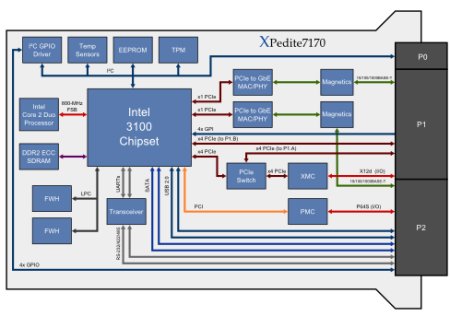VPX card runs Linux on Penryn
Sep 8, 2008 — by Eric Brown — from the LinuxDevices Archive — 5 views Extreme Engineering Solutions (X-ES) started shipping a Linux-compatible single-board computer (SBC) that adheres to the VPX military/aerospace form-factor standard. The XPedite7170 is equipped with a 45nm Intel “Penryn” processor clocked up to 1.86GHz, and offers USB, gigabit Ethernet, serial, and SATA… interfaces.
Extreme Engineering Solutions (X-ES) started shipping a Linux-compatible single-board computer (SBC) that adheres to the VPX military/aerospace form-factor standard. The XPedite7170 is equipped with a 45nm Intel “Penryn” processor clocked up to 1.86GHz, and offers USB, gigabit Ethernet, serial, and SATA… interfaces.
(Click for larger view of the the XPedite7170)
The ruggedized XPedite7170 is designed as a 3U VPX SBC for a variety of high-bandwidth military data-processing applications. It can be used in either the system slot or peripheral slot of a VPX backplane. It can be bought separately, or as part of an X-ES “ATR” mission computer, says the company.
Based on a “Penryn” 45nm Intel Core 2 Duo processor — either an SU9300 (1.2GHz) or SL9400 (1.86GHz) — the board ships with up to up to 4GB of DDR2 SDRAM and 4GB of flash soldered onboard. It offers dual x4 PCI Express Fat Pipe P1 interconnects, as well as up to two gigabit Ethernet ports, up to two serial connections, and optional dual USB 2.0 and SATA ports, says X-ES.
The board is said to adhere to levels 1-5 of the Ruggedized Enhanced Design Implementation (REDI) implementation of VPX, also known as “VITA 46.” Used mostly in mil/aero applications, VPX is maintained by VITA (VME Industry Trade Association), an incorporated, non-profit organization comprised of companies involved with real-time, modular, embedded computing systems. VPX offers improved connector technology compared to VITA's VMEbus standard, including support for serial fabrics and other modern bus technologies, while maintaining backward compatibility. Other Linux-compatible VPX SBCs include the VPX6-185 from Curtiss Wright Controls (CWC) and the GE Fanuc VPXcel3 SBC320 M.

XPedite7170 block diagram
(Click to enlarge)
The XPedite7170 can be configured to run at one of five REDI levels, from commercial to rugged mil/aero. Available either air- or conduction-cooled, the board offers a proprietary Xficient thermal conductivity technology, which the company touts as enabling systems to run at higher performance levels without overheating. The SBC also offers a PMC/XMC expansion that X-ES claims offers “easy product customization.” An optional front-panel I/O module is said to offer easier access to serial, Ethernet, and USB ports during development.
The XPedite7170 can be bought with a Linux Support Package (“LSP”), as well as board support packages (BSPs) for VxWorks, QNX Neutrino, and Green Hills Integrity. X-ES did not provide further details about the Linux implementation except to say that it is based on a Linux 2.6 kernel.
The XPedite7170 is said to include the following specifications:
- Format — 3U VPX (VITA 46) meeting REDI (level 1-5) requirements
- Processor — SU9300 (1.2 GHz) or SL9400 (1.86 GHz) Intel Core 2 Duo with 800MHz FSB and up to 6MB of L2 cache
- Memory — up to 4GB of DDR2-400 ECC SDRAM
- Flash — up to 4GB of NAND flash; up to 4MB firmware hub flash (or 2MB with redundancy)
- PCI — dual x4 PCI Express Fat Pipe P1 fabric interconnects
- Storage — dual SATA ports (optional)
- Networking — up to two gigabit Ethernet ports
- USB — dual USB 2.0 high-speed ports (optional)
- Serial — up to two RS-232/RS-422/RS-485 ports
- Other I/O — I(2)C port; X12d XMC P16; P64s PMC P14; 3.3V GPIO (optional)
- PrPMC/XMC site — 32-bit, 33-MHz PCI bus; x4 PCIe port; P64s P14 and X12d P16 I/O
- Front panel I/O — optional plugover module with RJ45 Ethernet, USB, and mini-DB9 RS-232 ports
- Dimensions — 3.9 x 6.3 inches (100 x 160mm); 3U VBX
- Power consumption — 31 W (at 1.8GHz), 26 W (at 1.4GHz)
- Operating system — support packages for Linux 2.6, QNX Neutrino, and Green Hills Integrity; Windows drivers
 ST8's “Spacecraft bus” (Click for details) |
An earlier XPedite board, the XPedite6031, is part of a Honeywell designed system that was selected for a NASA experiment aimed at proving the feasibility of COTS (commercial off-the-shelf) hardware and software for scientific space missions. The Linux-based experiment is designed to blast off in NASA's “New Millennium Program Space Technology 8 (ST8) mission (pictured) in November 2009. Other Linux-compatible XPedite systems include the XPedite6200 and the XPedite6240.
Stated Ben Klam, VP of Engineering for X-ES, “By offering the XPedite7170 in five unique ruggedization levels from commercial to rugged-military, the XPedite7170 can be configured to operate cost-effectively in any environment.”
Availability
An air-cooled commercial configuration of the XPedite7170 is available now for under $3,000 in volume, says X-ES. Conduction-cooled, rugged-military configurations range from $5,900 to $7,900, with pricing based on processor speed, memory configuration, and ruggedization level. More information may be found here.
This article was originally published on LinuxDevices.com and has been donated to the open source community by QuinStreet Inc. Please visit LinuxToday.com for up-to-date news and articles about Linux and open source.